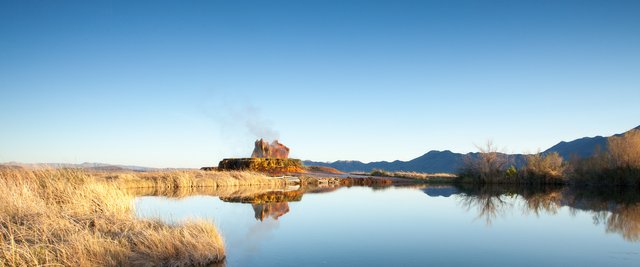
Every year we bring you a look at Burning Man's financial performance.
This year we're also going to take a deeper look at their major assets Fly Ranch and Decommodification, LLC.
Burners.Me Previous Financial Coverage: 2012, 2013, 2014, 2015, 2016
2017 Burning Man Annual Report
Some highlights:
- Revenue from Burning Man event $42.8 million, up over $5 million from 2016
- Annual Surplus (Revenue less Expenses): $3,733,876
- Donations received almost $1 million
- salaries (including contractors) increased $2.1 million
- Cash and receivables: $11.75 million, up from $9.5 million in 2016
- Total assets: $27.8 million

Sales of inventory was $1,605,516. That's a lot of ice and coffee. Ice cost $596,177.
Medical expenses were $649,000.
Their stock donation program seems to be working, with a donation of $26,517 in marketable securities.
Most of the key personnel got pay rises in 2017, though some went down:
d":37307} -->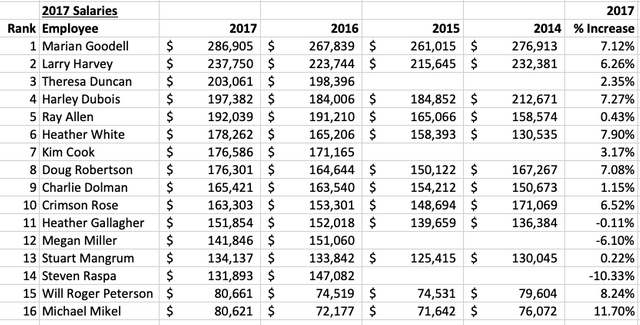
Overall payroll including contractors is $18,703,754 = 42% of revenues.
Grants as a % of revenues = 3.8% . Note this includes the cost of building The Man, the base structure, and partial funding of Playa art projects including the Temple.
The list of grant recipients contains many familiar names.
d":37313} -->
Burners Without Borders made 4 grants, totalling $4,900. [* this is for grants outside the US and has been disputed by BWB director Breedlove. See comments. I have asked him to provide the correct information, I will add it to the post - Ed.]
The annual Artumnal gathering took in $629,404 in 2017. About $100,000 of this went to pay for the use of the facility:
d":37312} -->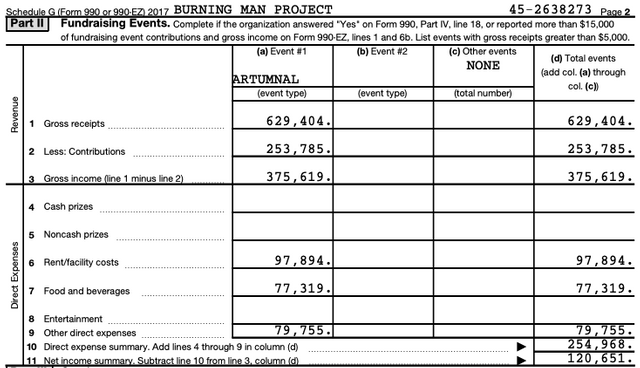
2017 Fundraising Event
This is a substantial increase on 2016:
d":37320} -->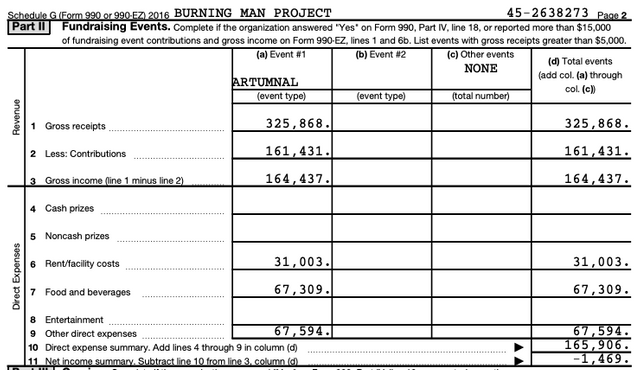
2016 Fundraising Event
Commentary
A huge thank you to A Balanced Perspective, DS and Anonymous Burner for their contributions and thoughts.
- Artists receive less than 2% of the budget (approx $800,000)
- Regionals receive about 4% of the budget ($1,717,766)
- About 9% of the budget gets piled up in the bank account as cash.
Anonymous Burner says:
The art funding is constantly presented as a central tenant of the event, but is actually getting funded like an afterthought. Artists are the face and the creativity of the core of the event, but have to carry their art on their own backs while others claim credit for making things so great for them
What does an organization trying to "make the world a better place" through art need with so much cash, into the tens of millions of dollars? Why do they spend such a tiny amount of the money given to them by Burners every year on art? Why do the ticket revenues increase 10% a year but the art budget seems to keep proportionally shrinking?
How can they justify spending $1 million a year on insurance without providing insurance for the 10,000 or so workers on site building the city, art installations and camps? Would it really kill their vision to make $3.5 million a year instead of $3.9 million, and look after their workers better?
Why does the main "charitable" organization have to spend more on the Regional Events than they give out on grants? It's about double the art budget. Is the purpose of Burning Man to spread Burner culture around the world through art, or is it to expand their inefficient bureaucracy? Can't the Regional events support themselves?
d":37297} -->

Population Summary (note: includes 2018)
The number of paid participants according to calculations in the Pershing County Sheriff's Office report was 69,493.
I filed a FOIA request to get the 2017 vendor list: 84 companies selling things other than ice and coffee.
DS has also been filing FOIA requests for information about Burning Man. He was able to get this heavily redacted information for 2017, the calculations used to pay the Bureau of Land Management's 3% fee.
d":37340} -->
Why the need for such secrecy?
The bulk of the $4,349,723 in Permits, Taxes and Fees appears to be the 9% Nevada Live Entertainment Tax. [* see comments - Ed.]
Decommodification
One of the interesting things in the 990 is the listing of "related entities". It includes Decommodification LLC, but the share of end of year assets is $0.
d":37324} -->
Decommodification LLC is the organization that was created at the same time as the non-profit Burning Man Project, to hold all the intellectual property. As far as we can tell, it gets paid $75,000 per year in royalties from the Burning Man Project for use of their trademarks. We have no information on what other royalties it earns, for example from sales of the documentary "Spark" or the "lines around the block" Smithsonian exhibit. Google recently commissioned Burning Man to design a $2 million art installation for their campus: where does this money go? Five lucky artists will get a share, most likely the "big names" who appear in the grants list on a regular basis. Is there a royalty component to deals like this?
Decommodification LLC made two filings to the California Secretary of State on January 16, 2019. One was that "nothing has changed", and another one requested that the company registration be canceled. It seems strange to me to file "no change" and "cancellation" notices on the same date, if anyone has knowledge of how this process works please leave a comment.
The current state of the company shows "cancelled" at the S.O.S. web site.
d":37325} -->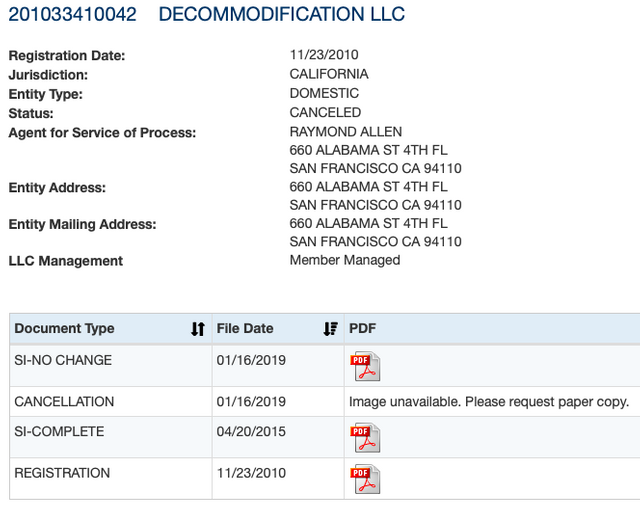
According to the US Patent and Trademark Office, the trademarks were transferred from Decommodification LLC back to the Burning Man Project on 28 April 2018 - the day Larry Harvey passed away.
d":37327} -->
The "nunc pro tunc" is a retroactive assignment to correct an earlier ruling. Was this something to do with Larry's estate?
What happened to the rest of the intellectual property, including the rights to future royalty streams?
Were the trademarks assigned back to the Burning Man Project for free, Decommodification LLC dissolved, and the accumulated cash of 6-7 years of royalties distributed to the members? Or was some of that $12 million cash hoard used to purchase them?
These transactions occurred in 2018, so perhaps will get covered in next year's IRS Form 990. There is no mention of them on the Burning Man web site, despite this being perhaps the most significant thing BMorg have done since spinning off their non-profit in 2012. BMorg like to claim they're a "leader in radical transparency", but Decommodification Inc has always been a mysterious black box.
The 2017 Form 990 values the Burning Man Project's intangible assets at $4.23 million, but this was before the trademark transfer. This amount first appeared on the books in 2014. We believe it represents goodwill on the acquisition of Black Rock City, LLC from the Founders.
For a good read related to Intellectual Property and Burning Man, see Culture, Capital and Copycats in a Globalizing Burnerverse by Ian Rowen, which was the keynote address at the 2018 Australia and New Zealand Burner Leadership Summit.
d":37329} -->
The "Burner Look" is not trademarked, so anyone can put an art car in a desert and appropriate our culture for "cool factor" and financial gain
Flysalen
In 2016 BMorg bought a 3800 acre parcel of land known as "Fly Ranch" with big donations and paid $6.5 million. This is why the 2016 donations were more than $8 million.
Around 42:30 in the above video, they start talking about "community ownership of land". The communist social justice component of this vision is that "living off the land is a version of Universal Basic Income".
Five minutes into the video, they reveal that the land has been sub-divided into 53 different parcels.
d":37334} -->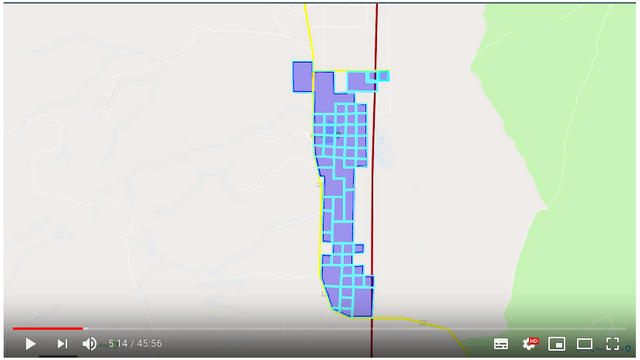
Who gets a permanent Burning Man lot? Presumably the 6 5 Founders and the millionaires who put up the $6.5 million. Will the rest be auctioned off to the highest bidder, or handed out to the most favored staff, artists, and camps? I'm tipping Dancetronauts are not on the short list.
This reminds me of an earlier post, Get Your Timeshare Slot in the Sultan. There, I postulated that the "ironic timeshare sales" brochures being handed out from a booth at the Man base was actually Burning Man's way of bringing that in as a future reality.
d":20883,"linkDestination":"custom"} -->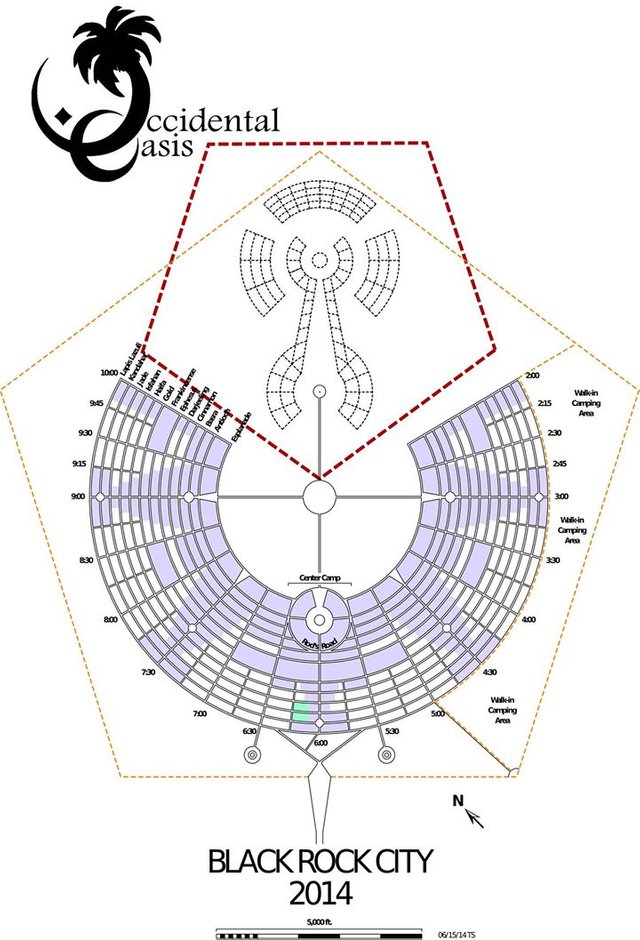
The Occidental Oasis "ironic" timeshare sale was going on at the same time as very real hotel sales on Billionaire's Row
The same thing happened with hotels, where BMorg director Chris Weitz opened an "ironic hotel" at Ashram Galactica, which paved the way for the proliferation of luxury Plug-N-Play hotel camps today.
d":22538} -->
Petit Ermitage, a boutique hotel in West Hollywood, were still advertising the pop-up Burning Man hotel they created with Cirque Gitane long after the event d":22557} -->
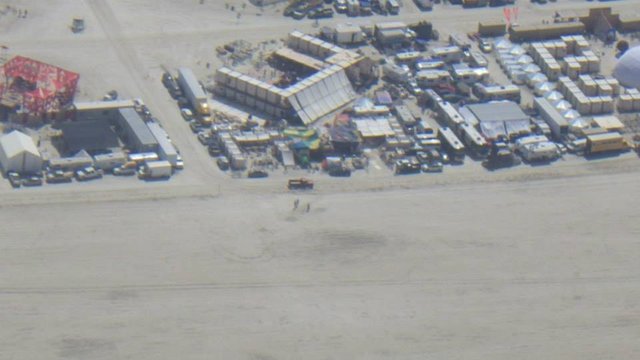
People now pay up to $20,000 for hotel rooms at Burning Man with flushing porcelain toilets
Photo: Lost Hotel/Facebook
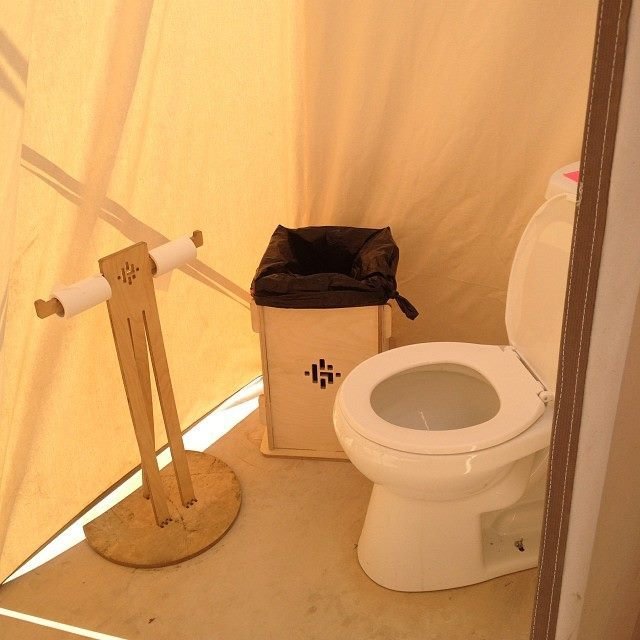
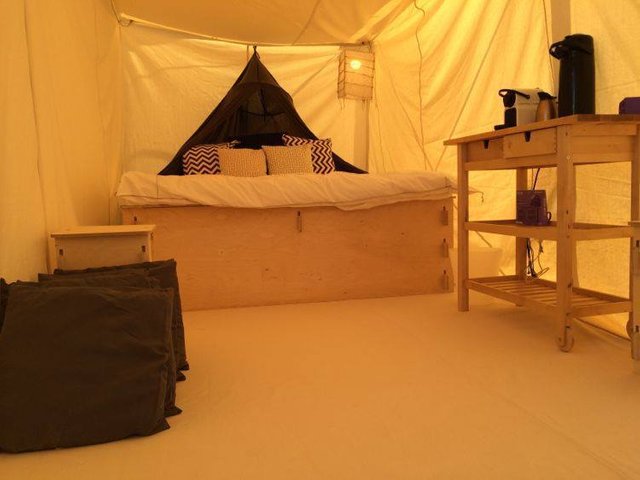
Fly Vision
Some information about the original intention for Fly Ranch is available thanks to the Wayback Machine
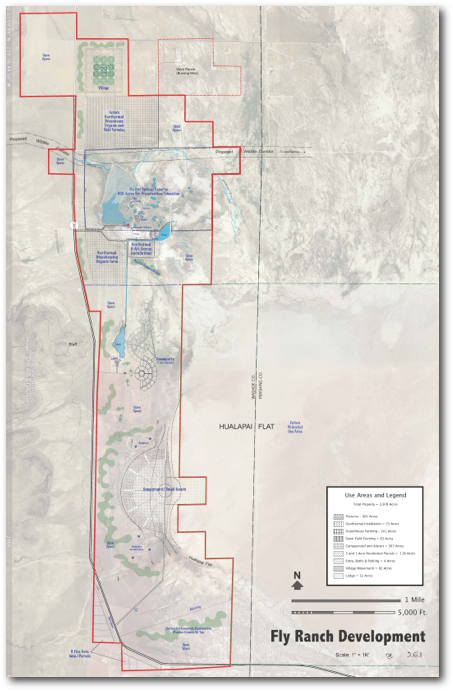
You can see from the plan above that the property is adjacent to another playa. Hualapai Flat is land administered by the Department of the Interior's Bureau of Land Management.
d":37362} --> d":37364} -->
d":37364} -->
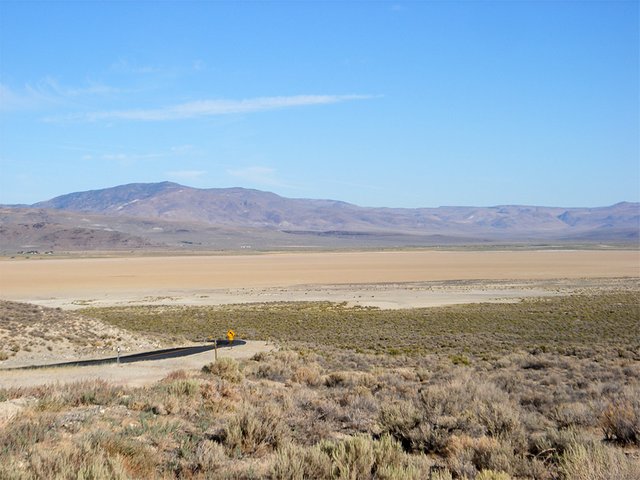
Image: americansouthwest.net
The Bureau of Land Management is planning to dispose of some of its lands.
d":37363} -->
Source: BLM Winnemucca District Program Overview 2017, Page 7
From the January 2018 report, it looks like this deal is close to being done:
d":37376} -->
Source: BLM Winnemucca District Program Overview 2018, Page 6
Who else would want empty desert playa?
The original vision for the Fly Ranch site was a sustainable community of one acre lots for employees and affiliates, with its own airstrip. This plan talks about 9 parcels of 5 acres, each with their own access roads; and 73 parcels of 1 acre each.
Village and Residential sites
The two communities are based on Burning Man's Ten Principles, and this will be it’s first year-round expression. Employees and affiliates may build on a ‘Homestead’ basis, or rent or buy into the Village community at the project’s north end. For others, one acre lots may be bought for home construction in the project’s central development (and separate H.O.A). These areas will be allowed to grow incrementally, with roads and utilities phased as required. Geo- thermal electricity will serve all the lighting and cooling needs of residents (and possibly the valley’s ranchers as well), and hot water will provide all heating.
Organic vegetable farming will be developed as an economic base for the village community. Geo-thermally heated greenhouse organic farming will be operated for local needs, and for transport and sale. This can supply Reno with organic vegetables throughout the year, while creating a wholly independent economy for the community.
Source: willroger.org, via Wayback Machine
Land Conservancy
Even with limited use, the grassy banks of the vernal pools are being sloughed in by bathers, the pools gradually churned into shallow mud holes. Bathers also leave tanning lotions, insect repellants, and
other contaminants behind to ill effect. The pond waters contain a species of pupfish which are isolated by the underground source and terminal outflow.A nature preserve requires control and enforcement, accordingly this area must be properly fenced to admit access only to indigenous animals, but excluding horses or cattle which trample wetlands. Human access must be highly regulated, with trespass, hunting and public use of existing pools and hot springs banned.
Anticipating the utter destruction of too much love, together with the projected costs of controlling and insuring against increasing liability, it is suggested that a Land Conservancy that is affiliated with Burning Man be created to manage the Geyser and wetland area.
Source: willroger.org, via Wayback Machine
Restaurant, Lodge and Conference Center
Fly Lodge and Conference Center
This will epitomize the style of Fly Ranch, and become a beacon for the greater community. A restaurant, rooms and services will be available. Fly Lodge will be available for public and corporate use, while also serving as World Headquarters for Burning Man’s Regional organizations around the globe.
Source: willroger.org, via Wayback Machine
Burning Man Board Member Chip Conley's experience with luxury boutique hotels and AirBNB would come in handy for a plan like this.
How Much For That Oasis In The Desert?
Burning Man's balance sheet shows land, buildings and equipment of $11.9 million; net of depreciation, $9.9 million. Schedule D, Part VI lists the value of land as $7,233,545 and buildings at $979,870. In 2015, before the Fly Ranch purchase, land was $198,000 and buildings $979,780.
According to Nevada property records, Fly Ranch only cost about $2.6M. The Washoe sales records record two transactions for $2.377M and $0.240M. The water rights came under two different transactions and appear to not have specific value attached to them. The water rights transactions gave the prior owner only about 64 acre feet of water for livestock.
d":37369} --> d":37367} -->
d":37367} -->
 d":37368} -->
d":37368} -->

There were four transactions in 2016:
1) sale of 3,381 acres that was the majority of FR,
2) another 276 acres that was part of the FR with the geyser
These sold the mineral rights but not the water but referred to other linked sales of water rights.
3) transfer of water rights with a carve out for the prior owner for item 1).
4) transfer of water rights with a carve out for the prior owner for item 2).
d":37333} -->
Water rights in California and Nevada are fresh on my mind after all the research I did for my last podcast episode, CryptoBeast #17 - Fire, Water, Trains, Space Lasers: California Burning. It's an arcane subject, but if you're interested there's a good overview here: History of Water Rights in Nevada and the Western States. This particular statement seems to be key:
Surface water rights initiated by applying water to beneficial use prior to March 1, 1905, and which have been perpetuated or continuously used through the years are known as vested water rights
The main water rights for the hot springs, Cottonwood Creek and Little Cottonwood Creek are the rare and highly coveted "vested water rights", granted before 1905.
My source tells me that the Burning Man event draws 12 million gallons of water per year from this property (27 acre feet).
Setting Boundaries
We recently published discussion from the Washoe County Commissioner's meeting about the possibility of redrawing district boundaries so that Burning Man would be part of Washoe County (which gets the economic benefits from event-related tourism) instead of Pershing County (which gets a massive spike in crime rates with no economic benefits).
Fly Ranch is next to Hualapai Flat. Burning Man was held at this location once, in 1997. Hualapai Flat is where Pershing, Washoe, and Humboldt Counties meet. Fly Geyser is in Washoe County.
Is the proposed Washoe Boundary move related to long-standing plans to purchase Hualapai Flat? Is BMorg sitting on $4 million from the Fly Ranch donations to acquire this land?
I guess time will tell.
[Update Feb 7, 2019 2:11pm]
The plot thickens, with this post saying that Burning Man was under contract to purchase Fly Ranch in 2009, and real estate developer Build SF helped organize their corporate restructuring to provide "personal financial security" for the 6 Burning Man founders.
In 2009, the BUILD partners were introduced to Larry Harvey and his partners at the Burning Man Organization. Burning Man was in contract to acquire a 4,000-acre ranch in the Nevada desert on which they planned to move the annual Burning Man event as well as develop a desert art center.
BUILD facilitated a transaction that allowed Burning Man to adjust its corporate structure, manage tax requirements, protect trademarks, establish a permanent office, and provide personal financial security for the six Burning Man partners. Real estate provided an elegant solution for these complex, multi-dimensional challenges, while preserving and honoring the basic precepts of Burning Man. We are proud of the part we played as advisors to Burning Man in establishing a clear path and solid foundation for everyone’s long-term benefit, including the event itself.
I have another trusted source who drew the "intellectual property in a separate company" structure on a napkin for CEO Maid Marian. I will ask their opinion on this.
[Update Feb 13. 2019 4:06pm]
Breedlove head of BWB has updated us with some more detail:
It’s interesting to see the difference between Part III 4c & Schedule F Part 1. I don’t quite understand how they split the difference between those two sections.
What I can provide you with is that we gave 4 grants through our Civic Ignition Process coming out at 4,900$ and 21 grants through our Annual Community Micro-Grant Program coming out at 18,800$. Between the two programs that totaled $23,700.
(https://www.burnerswithoutborders.org/projects/bwb-community-grant-winners-2017)We also provided grants for Hurricane Harvey Disaster Relief at $21,317.12
There was also a series of Fiscal Sponsor funds that were raised and given out. One of those being the $30,363 for the Camp Epic Santa Rosa Fire Relief (which is in one of your screenshots above)— but I don’t have the ability to pull up all those numbers at this time.
I’m also realizing while going through my data that it isn’t the easiest to find some of this stuff unless you know where to look. So taking a note on improving our reporting systems for the future– I appreciate the opportunity to look at how we can do better at reporting in a more transparent and better to find way.
Posted from my blog with SteemPress : https://burners.me/2019/02/04/burning-man-2017-financial-analysis-decommodification-and-flysalen/
WOW... What a good information... You shared a complete panorama of how an event even though it may seem like an explosion of madness and creativity has financial and legal aspects to cover... Excellent to share with my art students.
Downvoting a post can decrease pending rewards and make it less visible. Common reasons:
Submit
Thanks very much! How are things in Venezuela right now? Do many people there use Steemit?
Downvoting a post can decrease pending rewards and make it less visible. Common reasons:
Submit
This helped me learn some more about burning man and what it is but I am still confused, are you concerned with it’s nonprofit status but giving pennies of its money to the artists that give it success?
Posted using Partiko iOS
Downvoting a post can decrease pending rewards and make it less visible. Common reasons:
Submit
Yes. Burning Man is different from other festivals in that the promoters don't really provide anything. All the music, stages, art, bars, food, mutant vehicles, workshops, activities and entertainment is brought by the participants and given away for free. That makes the event highly profitable. They obtained a tax-free non-profit status by claiming that they would support the arts and spread the Burner culture throughout the world. But they give a pittance to the artists, most of whom are barely living above the poverty line. People love Burning Man for the art, so Burning Man should do more to support the art.
Downvoting a post can decrease pending rewards and make it less visible. Common reasons:
Submit
Highly rEsteemed!
Downvoting a post can decrease pending rewards and make it less visible. Common reasons:
Submit